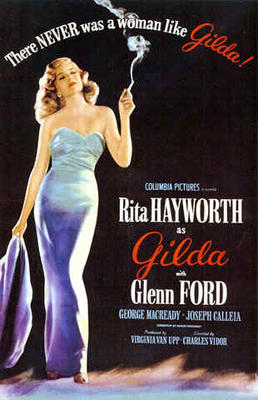 Nora's Nite
Nora's NiteHomemade Pasta Sauce with Sun-Fired tomatoes, Creme boule
I can never get a zipper to close. Maybe that stands for something, what do you think? - Gilda (Rita Hayworth)
Harry Cohn (July 23, 1891–February 27, 1958) was the founder of Columbia Pictures.It is said, in the industry, that while Harry Cohn ruled Columbia Pictures, the studio never ended a production year in the red. He was the subject of the famous quote from Red Skelton, who remarked of his well-attended funeral: "Give the people what they want, and they'll come out."
RITA HAYWORTH:
Margarita Carmen Cansino was born in Brooklyn, New York on October 17, 1918 into a family of dancers. Her father, Eduardo was a dancer as was his father before him. He immigrated from Spain in 1913. Rita's mother met Eduardo in 1916 and were married the following year.
Rita, herself, was trained as a dancer in order to follow in her family's footsteps. She joined her family on stage when she was 8 when her family was filmed in a movie called LA FIESTA in 1926. It was her first film appearance, albeit uncredited, but by no means was it to be her last.
Rita was seen dancing by a Fox executive and was impressed enough to offer her a contract. Rita's 'second' debut was in the film CRAZY DIABLO in 1934 at the age of 16. She continued to play small bit parts in several films under the name of Rita Cansino until she played the second female lead in ONLY ANGELS HAVE WINGS in 1939 when she played Judy McPherson.By this time she was at Columbia where she was getting top billing but it was Warner Brothers film THE STRAWBERRY BLONDE in 1941 that seemed to set her apart from the rest of what she had previously done. This was the film that exuded the warmth and seductive vitality that was to make her famous. Her natural, raw beauty was showcased later that year in BLOOD AND SAND filmed in Technicolor.
She was probably the second most popular actress after Betty Grable. In YOU'LL NEVER GET RICH with Fred Astaire, in 1941, was probably the film that moviegoers felt close to Rita. Her dancing, for which she had trained all her life, was astounding.
After the hit GILDA in 1946, her career was on the skids. Although she was still making movies, they never approached her earlier work. The drought began between THE LADY FROM SHANGHAI in 1948 and CHAMPAGNE SAFARI in 1952. Then after 1953's SALOME she was not seen again until PAL JOEY in 1957.Part of the reasons for the downward spiral was television, but also Rita had been replaced by the new star at Columbia, Kim Novak.
After a few, rather forgettable films in the 1960's her career was essentially over. Her final film was THE WRATH OF GOD in 1972. Her career was really never the same after GILDA. Her dancing had made the film and had made her. Perhaps Gene Ringold said it best when he remarked, "Rita Hayworth is not an actress of great depth. She was a dancer, a glamorous personality and a sex symbol. These qualities are such that they can carry her no further professionally". Perhaps he was right but Hayworth fans would vehemently disagree with him. Rita, herself, said, "Every man I have known has fallen in love with Gilda and wakened with me".
By 1980, Rita was, wracked with Alzheimer's Disease. It ravaged her so, that she finally died on May 14, 1987 in New York City. She was 68.


No comments:
Post a Comment